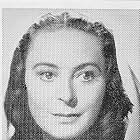Here Are Ladies
- 1971
- 1h
YOUR RATING
Photos
Storyline
Featured review
Siobhan McKenna's "Here Are Ladies" is an informative and very entertaining documentary filmed in 1971 in Ireland which represents several female characterizations created by Irish writers ranging from Gerorge Bernard Shaw to James Joyce. Instead of transcribing her one-woman legit show of the same title (presented in London in 1970 by Laurence Harvey and Wolf Mankowitz, followed by a 1971 Joseph Papp New York presentation and 1973 Broadway revival, all staged by Sean Kenny), McKenna has filmed the picture on actual locations where the writers lived and wrote about, and has added fine supporting performances by Abbey Theatre players. Resul is an engrossing and educational hour's entertainment, aided immeasurably by the star's anecdotes and concise delivery of historical background material.
Exposing McKenna's versatility, picture presents he in a moving closeup performance as Mrs. Tancred from Sean O'Casey's "Juno and the Paycock", a sad, wistful essaying of a graveside scene from John Millington Synge's "Riders to the Sea" as Moira laments the passing of the last of her six sons, and a sparkling reading of Winnie (buried in sand on a beach) excerpted from Samuel Beckett's "Happy Days". The context of these on-location perfs is often significant, as in McKenna's portrayal of George Bernard Shaw's "St. Joan", filmed in a moodily lit Irish jail.
The films' major highlight is a scene taken from Abbey Theatre writer Lennox Robinson's play "Drama at Inish". On stage, McKenna esayed all four roles herself, but here she is surrounded by three top Abbey players in an hilarious rendering of grand overacting, as a scene from a mock Russian drama is enacted for two uncomprehending Irish folk. McKenna's handling of varied Irish and British accents and widely different acting styles is on view.
Picture ends with a lengthy two-handed scene of women washing clothes at a stream taken from James Joyce's "Finnegans Wake". Displaying the musicality and hypnotic rhythms of Joyce, scene carries over a problem from McKenna's legit version, in that the thick accents employed resist intelligibility. Film suffers from the omission of the live show's highlight, the Molly Bloom soliloquy from Joyce's "Ulysses", but still it preserves, for posterity, a fine sampling of McKenna's thesping art, significant since she has only appeared in a dozen feature films in her career.
Direction by John Quested (who also helmed "Philadelphia Here I Come" with McKenna) is simple and effective, and picture deserves wider distribution, having fallen into obscurity since winning a prize at the 1971 Venice Film Festival. Cable or broadcast tv usage would be a natural.
Documentary has no writing credit, but given the personal nature of some anecdotal material it is likely that McKenna wrote the commentary. Other works excerpted in addition to those noted above are O'Caseys "The Plough and the Stars", four Crazy Jane poems by W. B. Yeats and James Stephens' "The Crock of Gold".
My review was written in March 1983 after a screening at Thalia theater on Manahttan's UWS.
Exposing McKenna's versatility, picture presents he in a moving closeup performance as Mrs. Tancred from Sean O'Casey's "Juno and the Paycock", a sad, wistful essaying of a graveside scene from John Millington Synge's "Riders to the Sea" as Moira laments the passing of the last of her six sons, and a sparkling reading of Winnie (buried in sand on a beach) excerpted from Samuel Beckett's "Happy Days". The context of these on-location perfs is often significant, as in McKenna's portrayal of George Bernard Shaw's "St. Joan", filmed in a moodily lit Irish jail.
The films' major highlight is a scene taken from Abbey Theatre writer Lennox Robinson's play "Drama at Inish". On stage, McKenna esayed all four roles herself, but here she is surrounded by three top Abbey players in an hilarious rendering of grand overacting, as a scene from a mock Russian drama is enacted for two uncomprehending Irish folk. McKenna's handling of varied Irish and British accents and widely different acting styles is on view.
Picture ends with a lengthy two-handed scene of women washing clothes at a stream taken from James Joyce's "Finnegans Wake". Displaying the musicality and hypnotic rhythms of Joyce, scene carries over a problem from McKenna's legit version, in that the thick accents employed resist intelligibility. Film suffers from the omission of the live show's highlight, the Molly Bloom soliloquy from Joyce's "Ulysses", but still it preserves, for posterity, a fine sampling of McKenna's thesping art, significant since she has only appeared in a dozen feature films in her career.
Direction by John Quested (who also helmed "Philadelphia Here I Come" with McKenna) is simple and effective, and picture deserves wider distribution, having fallen into obscurity since winning a prize at the 1971 Venice Film Festival. Cable or broadcast tv usage would be a natural.
Documentary has no writing credit, but given the personal nature of some anecdotal material it is likely that McKenna wrote the commentary. Other works excerpted in addition to those noted above are O'Caseys "The Plough and the Stars", four Crazy Jane poems by W. B. Yeats and James Stephens' "The Crock of Gold".
My review was written in March 1983 after a screening at Thalia theater on Manahttan's UWS.
Details
- Release date
- Language
- Production company
- See more company credits at IMDbPro
- Runtime1 hour
- Color
Contribute to this page
Suggest an edit or add missing content
